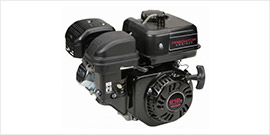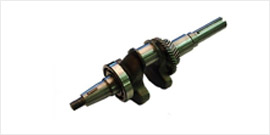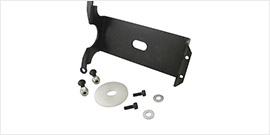.png) NR Racing Camshaft Selection & Information There are four important numbers on a cam: ICL (intake centerline), LS (lobe separation), duration, and lift. Don’t worry too much about lift. The Honda head (i.e., port design) does not respond much once the lift at the valve exceeds about .350. A .275 lift cam with 1.3 ratio rockers will achieve this. We have spent a lot of time on the flow bench, and unless the head is radically changed, you will not see much gain past .350 lift. Duration is another story. This is how long the valve is kept open. Hondas love lots of duration. We have run as much as 300 at .050, but 260 seems to be a good compromise for better power and tractability. As duration goes up, so does the RPM, at which maximum power is made. At the same time, idle quality goes down along with low-end torque. An engine with a lot of duration will scream and make lots of power, but can be a dog off the corners and/or when trying to get started. Not to mention it idles at 3000 rpm. Typically, 210 to 220 makes for high torque motors that start and stop a lot, use low RPM stall/clutches, and see a wide range in operating RPM. These motors will peak somewhere between 4500 and 5500, and will pull to 6500. 250 to 260 are for the 7000+ motors that don’t see RPM much below 5000. Needless to say, 230 to 240 cams fall in the middle. One interesting thing about duration: the smaller the carb, the more duration can help a motor. With small carbs, usually the cam/ports will flow more than the carb can deliver. The only way to improve power is to hold the valve open longer. In other words, where going from a 240 to a 260 cam on a motor running a 28mm Mikuni will only show a 10% improvement in peak HP, doing the same on a motor with a stock carb can show a 20% improvement! Almost as critical as duration is the ICL. This is the intake opening and will range from 98 to 116 degrees F. It is also referred to as retard or advance in the cam. This determines where the peak torque will occur. Most cams fall in the 102 to 110 range. FYI: Honda 160s are around 105, and GX200s are around 110 from the factory (retarded for emissions). A cam with a 102 will have power range/peak around 1000 to 2000 rpm lower than a cam with 110 ICL. It will also have considerably more low-end torque and will pull a lot harder off the corners. For very, very small tracks, this can translate into significantly lower lap times despite having lower HP. For boats, winch boarding, and rock climbing ATVs, these cams can make huge differences. Depending on the application, it is possible to stall a motor that has a high ICL, whereas advancing the cam produces great results. At the other extreme, a cam with 114 ICL might peak in the 9000-rpm range. On a large track (1/2 mile) where the RPMs never get below 7500, it would be unbeatable. However, you would need a clutch that engages at 5000+ just to get moving. Not always fun for a street toy! The other important number is the LS (lob separation), which determines the amount of overlap. These will range from 100 to 115, but most cams will be in the 106 to 110 range. As a general rule, the lower the number, the more HP, but with a smaller power band. However, the wider (less overlap) the LS, the more dynamic compression a motor can build. For high compression engines, overlap is needed to bleed off compression at lower RPMs, preventing detonation. Anything over 11 to 1 should be using a 106 to 107 LS. For lower compressions, it depends on how wide a power band is desired. If you want a power band of only a few 1000 rpm (typical for oval tracks), then go with a narrow LS; however, if your RPM ranges from 2000 to 7000 (road courses), then you may want a wide LS. The duration, ICL, and LS all work together, and changing any or all of these numbers can have a significant impact on how a motor performs. One final note: what works on the dyno does not always work on the track and vice versa. What works great in a mini bike may not be the best for a kart; a dirt track cam is not going to be the same as a paved cam; etc.. CAM NUMBERING SYSTEM NR Racing cam part numbers tell the lift, the intake lobe center, and the lobe separation. ● The first 3 numbers tell the lift, so a 252-0207 cam is .252 lift. A 274-0611 is .274 lift. ● The fourth and fifth numbers tell the intake centerline (must add 100), so a 252-0207 cam has a 102 intake centerline, and a 274-0611 cam has a 106 intake centerline. ● The six and seventh numbers tell the lobe separation (must add 100), so a 252-0207 cam has a 107 lobe separation, and 274-0611 cam has a 111 lobe separation. *Note: Lobe separation is calculated by adding the intake and the exhaust centerlines and dividing by 2. To get the Exhaust Centerline, use the following formula: ECL = (2 x LS) – ICL ● The letter “P” after the part number will indicate old style Predator. NOTES ON CAM INSTALLATIONS Small Blocks: ● GX200, 6.5 Clones, and Hemi Predators use the same cam. ● Old style (non-hemi) Predators use a cam with a .009" larger journal. ● 274 cams use 1.3 rockers, 307 cams use 1.2 rockers, and both use dual springs (and 320). ● 252 and 280 use single springs and 1.2 rockers. ● On GX200 Honda blocks, the block must be clearanced for 274 and larger cams. ● 6.5 clone blocks will clear most cams without clearancing; however, due to manufacturing differences, this is not always true. ● Hemis may have a rod-to-cam interference on all cams except stock. ● 224 Predators can use GX200 and 212 Hemi style camshafts, but must be clearanced along the shaft and lobes to fit. Big Blocks: ● GX270-GX390, 420s, and 460s all use the same cam. ● Some 301 motors use a large journal cam. GENERAL RECOMMENDATIONS Note: Because of many variables, cam performance may vary with motors, tracks, and even drivers. Our recommendations are only a starting point, and you may find a different grind may actually perform better for you! Backyard Karting ● 280-0611 for great all-around Oval Track Racing ● 252-0207 for very small tracks - maximum of 6000 rpm ● 274-0207 on/off the gas to 7500 rpm ● 274-0607 breathing in corners to flat foot high bank, 8500 rpm ● 307-0807 maximum all-out power, flat footed low bank Road Racing ● 252-0611 tight course, 6500 rpm maximum on straights ● 274-0611 long straights Mini Bikes ● 252-0611 for all around ● 274-0607 for racing only ● 280-0611 for all around, bigger builds Drag Racing ● 292 Series Mud Motors ● 230-0211 marine for mild ● 252-0211 marine for big carbs Snow Mobiles ● 280-0611 for most applications, including racing ● 292 series for grass drags CAM GRINDS – SMALL BLOCKS 230 SERIES: Special Cam for Classes with Lift-Only Rules This cam has approximately .230 lift with 30 degrees more duration than stock. It provides a significant power increase over stock while maintaining factory lift. Cam may have noticeable idle. Cam will not pass visual inspection. Cam is bolt-in, and it does not require block modifications, yet keeps close to the stock base circle to maintain correct valve train geometry. Works best with 22lb springs (6500 rpm). You can use 26lb springs and will be able to achieve higher RPMs; however, you may experience cam wear. Options:
252 SERIES: Approximately .252 Lift and 230 Degrees Duration (at .050) This welded and ground cam provides significant power improvements over a stock cam. Works best with mild motors using bored OEM or aftermarket carbs. Cam is bolt-in and does not require block modifications, yet keeps close to the stock base circle to maintain correct valve train geometry. 26lb to 37lb springs should be used. Great with 1.3 rockers. OUR #1 SELLER! Options:
*Note: Marine and winch board applications work best with 252-0211. Mini bikes work best with 252-0611. 275 MONGOOSE PERFORMANCE CAMSHAFT Approximately .272 lift and 245 degrees duration (at .050). Ground and hardened (non-welded), high-performance cam designed for wide powerband with awesome increases in mid-range power. Works best with bored OEM or aftermarket carbs. 26lb springs recommended. 6500-7500 rpm based on springs and carb. Approximately .274 lift and 260 duration. Square lobe design to maximize valve opening time. While meant to be used with larger carbs, it actually works very well with smaller carbs by holding open the valve as long as possible with reduced lift to maximize velocity. Honda blocks may need to be clearanced to install. Dual springs recommended (37lb will work, but will limit RPM to 7500). Options:
280 SERIES: The Original NR Camshaft - King of Mid-range - GREAT FOR MINI BIKES & MARINE APPLICATIONS Approximately .280 lift and 220 duration (at .050). This is a nice cam that works well on both stock and modified motors. This cam produces lots of low-end torque. One of the best all-around cams we offer. Honda blocks may need to be clearanced to install. 26 lb springs required. Bored or aftermarket carb needed. Options:
285 SERIES: Serious Mid-range Camshaft for Serious Motors - Lobe Specially Designed for Honda GX Series Approximately .285 lift and 250 duration (at .050). Cam allows use of stock valves with 1.2 rocker arms when using our springs. This cam likes big carbs and big ports. Will easily make 20hp when used with the correct combination. Works best with 24mm Mikunis, big valves, and high compression. Honda blocks must be clearanced to install. Options:
Approximately .292 lift and 260 duration. Square lobe design to maximize valve opening time. 108 ICL, 110 LS. Works well in most high-RPM applications, but designed for a wide RPM range to maximize acceleration. Honda blocks may need to be clearanced to install. Dual springs recommended (37 lb will work, but will limit RPM to 7500). 307 SERIES: All-out Racing Camshaft for Serious Motors and Big Tracks Approximately .307 lift and 260 duration. This cam took 6 months to develop. Special ramp designed for Honda GX200s running 12 to 1 or higher compressions using race gas or methanol. Use with dual springs and 1.2 rockers. This is the cam for 20+ HP motors. 9,000 rpm. 12 to 1 compression or more. 108 ICL, 107LS. Note: Use of rockers longer than 1.2 with dual springs, may result in retainer to guide interference. Block or crankshaft may require clearancing to clear camshaft lobes. 320 SERIES: The Biggest, Baddest Cam for GX200s! Approximately .320 lift and 260 duration. Requires dual springs and special attention to the valve train. Block and rod must be clearanced to install. Options:
CAM GRINDS - BIG BLOCKS 250: The Twister Cam - High Performance Grind for GX270 to GX390, 420 Predator, and 13/15hp OHV The Twister is a high-performance grind, providing significant power increase over the stock cam at a great price. Developed on the dyno and the track to maximize power on GX270s, GX390s, 420 Predators, and 13/15hp Chinese OHVs. Stock lift with increased duration and optimized valve timing for a wide powerband (2000-5000+ rpm), providing a drastic improvement throughout the entire RPM range. This cam is easy on the valve train and will not "beat up" your valves or lifters. Recommended for yard karts, mud motors, short track go-karts, marine, pulling/towing, mini bikes, and anything else where a broad powerband is necessary and loss of low end is unacceptable. Also great for racing classes that require stock lift. Cams are cut on a close base circle to the stock cam so that the compression release is still functional. *Use NR Racing HD single valve springs only (no dual springs). 280 SERIES: (GX240s to GX390s) The Torque Cam - Massive Amounts of Low-end Power for Marines, Mini Bikes, and Small Tracks Approximately .280 lift and 220 duration (at .050). This is a nice cam that works well on both stock and modified motors. This cam produces lots of low-end torque. One of the best all-around cams we offer. Works with stock, bored, or aftermarket carbs. Note: Honda blocks or crankshaft may require clearancing to clear camshaft lobes. Fits Honda GX240 through GX390, 420 Predators, 460cc OHVs, and most other 9-15hp Honda style OHV motors. Will not fit 414 LCT motors or some 301 Predators with large journals. Options:
306 SERIES: Race Cam with Awesome Mid-range Power Serious race cam with awesome mid-range power camshaft for serious motors. Lobe designed especially for Honda GX270-GX390 motors. Approximately .306 lift and 240 duration (at .050). This cam likes big carbs and big ports. Best cam for 240 to 301cc (especially GX270) engines. Best HP cam for GX270s. Also great for GX390s wanting excellent torque. Note: Honda blocks or crankshaft may require clearancing to clear camshaft lobes. Fits Honda GX240-GX390, 420 Predators, 460cc OHVs, and most other 9-15hp Honda Style OHV motors. Will not fit 414 LCT motors or some 301 Predators with large journals. Options:
307 SERIES: All-out Race Cam for Big Blocks (GX390s and 11/15 hp Honda Style OHVs) on Small Ovals or that Require Extra Torque The 307 Series camshaft is for serious motors and big tracks. With approximately .307 lift and 260 duration, this cam took us six months to develop. Special ramp designed for running 12 to 1 or higher compressions using race gas or methanol. Use with dual springs and 1.3 rockers. This is the cam for 30+ HP motors. RPM Grind: 7,500+ RPM. 12 to 1 compression or more. Dual springs required. High HP grind for ¼+ mile tracks.
Note: Honda blocks or crankshaft may require clearancing to clear camshaft lobes. Fits Honda GX240-GX390, 420 Predators, 460cc OHVs, and most other 9-15hp Honda style OHV motors. Will not fit 414 LCT motors or some 301 Predators with large journals. |
Get 6 Months To Pay On Purchases of $99 or more with


